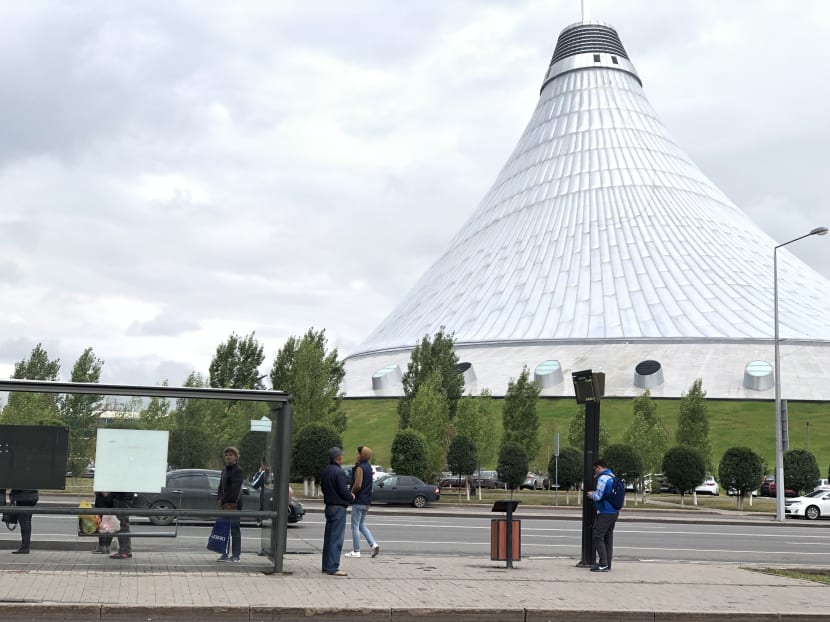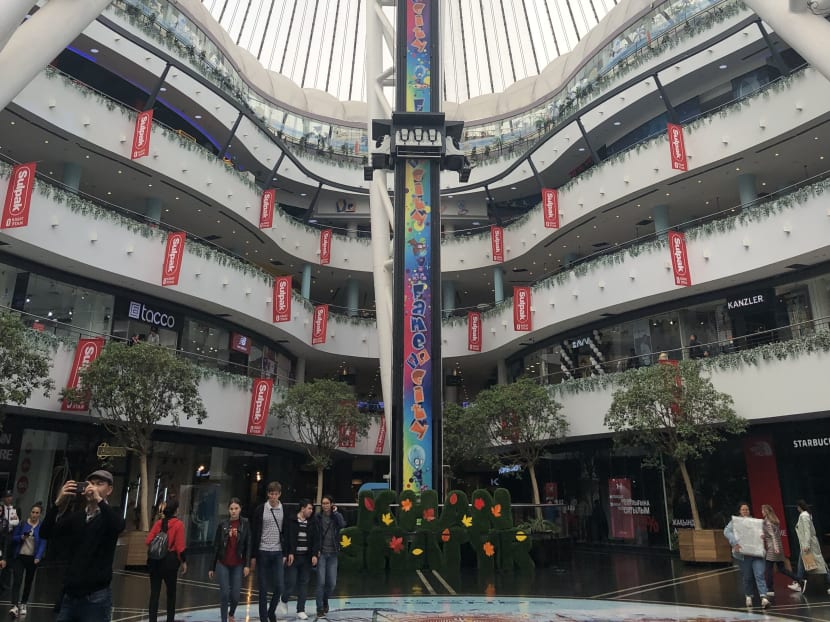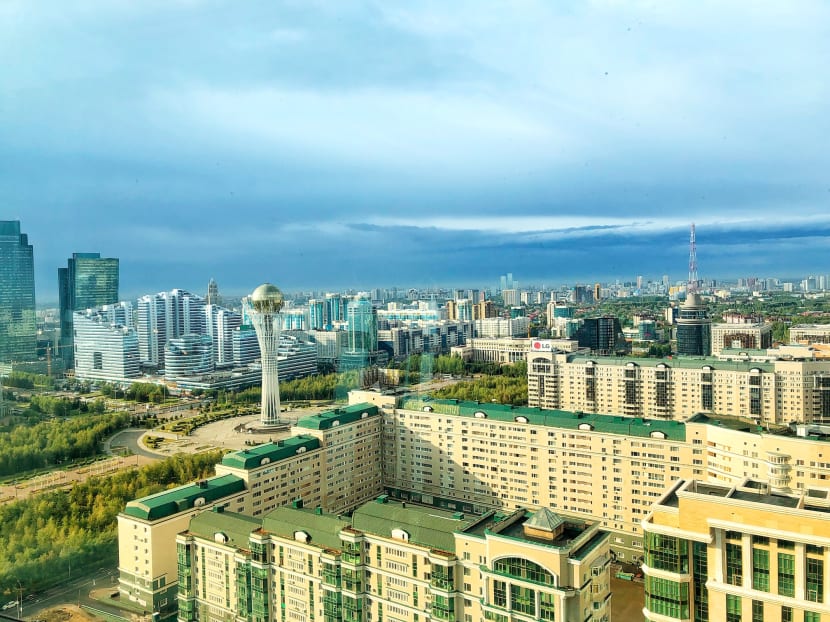In Kazakhstan’s capital, no Borat, only gleaming skyscrapers and modern architecture
It was a rainy Sunday morning in Kazakhstan’s capital, Nur-Sultan, and I did what most Singaporeans would do — head to a shopping mall. I had no idea what was in store.
It was a rainy Sunday morning in Kazakhstan’s capital, Nur-Sultan, and I did what most Singaporeans would do — head to a shopping mall. I had no idea what was in store.
When I entered the Khan Shatyr Entertainment Centre, it overwhelmed every suburban mall which I have been to back home. It was huge. I guess size does matter.
The architecture is an imposing, leaning yurt that forms part of the city’s skyline — its design a nod to the country’s nomadic culture where people set up tent houses wherever they went. This “tent”, by the way, is the largest in the world.
The mega-mall houses close to 200 shops and food joints, an amusement park featuring a 38m high drop tower right in the centre of the tent, and on the top-most floor, a temperature-controlled man-made beach, complete with deck chairs and sand imported from Maldives. It’s like VivoCity and Sentosa merged into one.
On its own, the mall is intriguing. Yet, it looks right at home in a city full of unusual architecture, which makes the place feel like something from a sci-fi movie.
Further down the mall on the same axis is the Bayterek Tower, an observation tower shaped like a tree with a golden egg nestled among the branches. On the other side of the Ishim River is the Palace of Peace and Reconciliation, a 77m high pyramid of glass and steel.
Next to it, the Shabyt Art Palace which houses an arts university and a library, is a concave lens-like structure that looks like a grand glass bowl. Everything looks spanking new and gleaming.
My room in the Hilton Astana looked out to the grand Nur Alem glass sphere, built specially for the World Expo which Kazakhstan hosted in 2017, the first Central Asia country to do so.
Nur-Sultan’s development is all the more impressive when one considers that some 20 years ago, the city did not exist.
In 1997, the country’s first president Nursultan Nazarbayev moved Kazakhstan’s capital over from Almaty. Back then, there were no skyscrapers or modern structures, just a small town by the Ishim River known as Akmola, surrounded by endless grasslands.
In fact, inside the Nur Alem which provides panoramic views of the city, one can still see clearly where the high-rise structures end, and where the grasslands begin.

With the move, Akmola was renamed Astana, which means the capital in Kazakh. Since then, the city has risen from the grass, every building and development planned and constructed according to the president’s vision.
When he stepped down in March this year after a 30-year reign, the capital was renamed Nur-Sultan to honour him.
On my first night in the capital, after a hearty dinner of lamb stew at a restaurant that serves local cuisines, I wanted to take a post-meal walk down the central axis to explore the architectural sights. I had mapped out a route on Google Maps. Yet, out on the streets, I realised it was impractical to explore the city on foot.
The streets are wide and landmarks spaced out. Buildings that look close enough on the map are at least a 30-minute walk away. With autumn just beginning, persistent light rains that went on for half a day were common and the city was often enveloped in grey and cold.
It was 13°C out that night, and even though I’d bundled myself up in several layers, my tropical cheeks felt stiff. The young waiter, who was dressed in a short-sleeved shirt, told me that autumn is a comfortable season and he enjoyed the winds. I asked if he found it cold, and he laughed. “I’m from the north, this is nothing to us,” he said.

I ended up walking for five minutes, then quickly hopped in a Yandex, the local equivalent of Grab, and went back to my hotel.
In Nur-Sultan, winters can go on for more than six months and temperatures can drop to minus 40°C. Much of life freezes over then.
Perhaps this is why malls are huge, and often built with entertainment centres such as skating rinks and arcades for children, so families can while away time during the winter months.
For a capital that looks decidedly futuristic, its people still hold on to traditional values. The norm, I learnt, is for couples to get married almost immediately after graduating from university, at about 25.
They have children young, and most families go on to have at least two or three kids. No Total Fertility Rate issues in Kazakhstan!
The capital has been working to woo visitors. The First Forum of Asian Countries’ Writers, an inaugural writers’ fest held in September, gathered writers and journalists from all across Asia, including Malaysia, Brunei, Turkey and Mongolia. Months earlier, it also hosted a comic convention which featured Game of Thrones actor Pilu Asbæk.

When I sat down for a chat with Timur Duisengaliev, deputy chairman of the board of national company Kazakh Tourism, he shared that the country has a vision to boost tourism to 8 per cent of the gross domestic product. It currently stands at 1 per cent.
He said tourist numbers stand at 8.5 million annually, but most of them are in fact migrant workers from Uzbekistan and Kyrgyzstan getting to Russia, who stop over in Kazakhstan for one or two days. The country aims to up the number of “quality tourists” to nine million.
“We want to attract more quality travelers to Kazakhstan. There is a lack of information out there about this country and we need to change the perception of what foreigners think about us,” he said.
I told him that my friends back in Singapore had joked that I might meet Borat in Kazakhstan, the lead character in a 2006 movie of the same name, played by Sacha Baron Cohen.
He was incredulous. “Still? It’s been so many years,” he exclaimed.
It is clear he has mixed feelings about the movie, which presented Kazakhstan as a backwater region. He cited examples of popular shows that have done wonders for tourism, like what Game of Thrones did for Croatia, and The Lord of the Rings for New Zealand.
“In any case, Borat was promotion and information… But maybe we can make Borat 2, and this time we can show the real Kazakhstan.”
ABOUT THE AUTHOR:
Pearl Lee is a senior content manager at The Nutgraf, an integrated content marketing firm.







